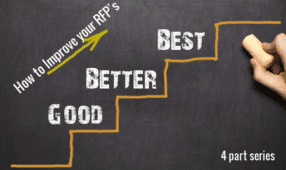
Part Three of Four
In part one and two of this series we covered the importance of providing a clear, concise and detailed proposal. In part three, we will touch on the remaining components, the presentation and on responsibilities for your RFP document.
Let’s start with some good news — quite often another department like engineering or your technical group is responsible for providing the scope or the technical component of the RFP. They are responsible for putting together the guts of the proposal and the reason why you are issuing the proposal in the first place. You have heard the term “garbage in, garbage out”. Well, if you put garbage in your proposal, it is likely you will receive garbage in response.
As a buyer, you are typically responsible for incorporating this scope or detailed specification somewhere into the document. You need to construct or put the proposal together in a manner that makes sense to the bidder.
Other areas you need to focus on are the table of contents, the commercial terms, conditions, dates, site visits, meetings and ultimately putting together the evaluation and recommendation from all of the bids received. It is at this point you need to be cognizant of insurance, environmental, regulatory requirements and little things like payment terms.
What are some of the practices you can do to improve presentation and more importantly simplify this task?
- Much of a previous RFP can be re-purposed and when you have a good basic template to build from, it will make the process much less cumbersome.
- Approach a colleague for a sample template. If you are at a new organization and or are new yourself to purchasing, this would be a good time to call in a favor. I know this would be my first phone call! Reaching out to colleagues will save you hundreds of hours of time and frustration. Networking is important and as mentioned will make your life easier when you stumble into an area you have little experience with.
- Be inquisitive, read, attend courses and enroll in a professional development program designed for purchasing professionals.
- Any time you see a posted RFP take the time to peruse it and make note of what areas might work for your organization. We are not endorsing plagiarism here, simply look at the format. If there is specific terminology you prefer you can modify, rework and edit the text. It is strictly a means of helping you formulate a quality template, a desired flow and general appearance for your own presentations.
- And last, subscribe to sites like www.rfptemplates.org for helpful hints and tips. Visit our homepage, subscribe and receive a FREE sample pack.
Preparing or writing a RFP is a very unique exercise and not necessarily a task a Buyer will perform everyday. The good news is it does get easier with each one you create. So take every new proposal you write as an opportunity to learn and develop your technique.
We did neglect to point out that we do have a solution and a way to make your life easier. Purchase our quality templates to help you get that running start. If you are interested in purchasing one of our bundles please visit our How to Buy Page.
In case you missed it here are the links to:
Part 1 – How to Improve your RFP
